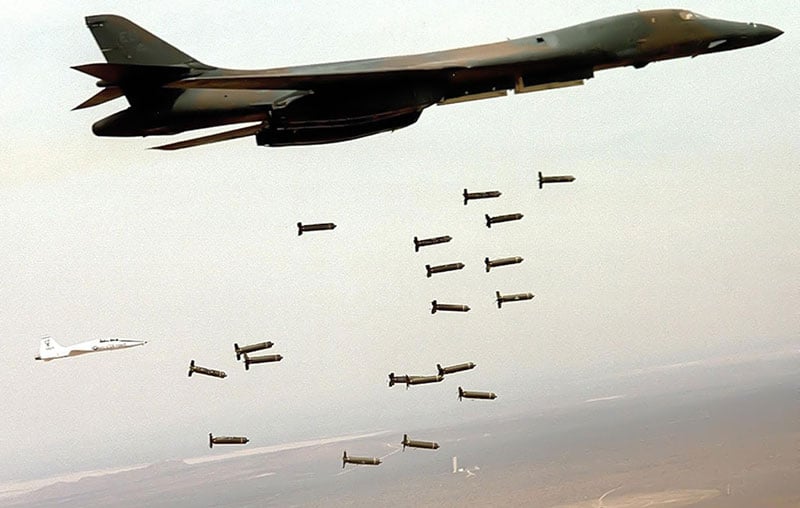MAI QUYEN
Following the US decision to supply cluster bombs to Ukraine and Russia's announcement of similar retaliation, world public opinion is concerned about new catastrophic consequences of cluster bombs that history has witnessed many times.
A US Rockwell B-1 Lancer bomber drops cluster bombs during a 2020 exercise. Photo: AFP
According to CNN, cluster bombs look like conventional bombs but contain dozens to hundreds of small projectiles inside. While cluster bombs can be dropped from aircraft, cluster munitions are launched from artillery, naval guns or rocket launchers. At a certain altitude, the large bomb will separate and spread the sub-munitions inside over a wide area.
Submunitions are designed with timed fuses, depending on the area they will explode when approaching the target or touching the ground, firing many small pieces of bullets to destroy enemy infantry or armored vehicles such as tanks.
The pain of cluster bombs
According to the Independent, cluster bombs have a long history with the first recorded deployments in World War II. Some conflicts during this period saw the appearance of cluster bombs, such as the Battle of Kursk in 1943 when the Soviet Red Army launched cluster bombs against Nazi Germany. In the same year, the German army dropped 1,000 SD-2 bombs (an early version of the cluster bomb, also known as butterfly bombs) on Grimsby, a port city in the northeast of England.
With a more effective mass-killing power than individual artillery shells, cluster bombs were used throughout the Cold War. The US dropped 413,130 tons of cluster bombs or munitions on Vietnam between 1965 and 1973. During the Vietnam War, the US dropped an estimated 270 million cluster bombs on Laos, of which up to 30% failed to explode. Laos was contaminated by an estimated 80 million bombs or submunitions, affecting all 17 provinces and causing 300 casualties each year. When it launched its military campaign in Afghanistan in 2001, Human Rights Watch (HRW) said the Pentagon considered cluster bombs an integral part of the war, and in the first three years of the conflict, HRW estimated that the US-led coalition dropped more than 1,500 cluster bombs on the Central Asian country. The last time the US used cluster bombs was in the Iraq campaign in 2003. To date, more than 20 countries have used cluster bombs in armed conflicts, and wars in more than 35 other countries.
The Soviet Union in 1979-1989 also used a lot of cluster bombs in the war in Afghanistan, followed by Russia in the first Chechen war (1994-1996). Some other military attacks using cluster bombs in the world include the Indochina war between India and China, the war in the Falkland Islands between the UK and Argentina, the first Gulf War, the Eritrea-Ethiopia conflict and the Kosovo conflict. During the month-long war in 2006 with Hezbollah, HRW and the United Nations (UN) accused Israel of firing up to 4 million cluster bombs into Lebanon, threatening civilians in this Middle Eastern country to this day. The Saudi-led coalition in Yemen has also been criticized for using cluster bombs in its military campaign against Houthi rebels. In 2017, the UN said Yemen was the second most at-risk country for cluster bomb deaths after Syria, which has been in the midst of a civil war since 2011.
Long-term consequences
According to weapons experts, cluster bombs are capable of causing high damage over a wide area, but the rate of falling off target and not detonating on impact is not low (40%). This means that thousands of unexploded bomblets continue to remain, injuring or killing civilians for decades after the war. "The legacy of cluster bombs is suffering, death and the cost of cleaning up after their use for generations," US Representative Betty McCollum said in a statement opposing the White House's provision of cluster bombs to Ukraine.
Citing a 2006 study by Handicap International, the Washington Post reported that 98 percent of cluster bomb casualties were civilians. It is estimated that the weapon has caused at least 55,000 non-combatant casualties since the 1960s. In addition to the human toll, Congressman Joaquin Castro of the US House Foreign Affairs Committee said that spending millions of dollars to clean up the damage decades later is a lesson enough for the world to abandon cluster bombs. According to the US State Department, the US has spent more than $4.6 billion to help other countries clear mines and other unexploded ordnance since 1993. In fiscal year 2022 alone, Washington provided more than $376 million in support for conventional weapons destruction activities in more than 65 countries and regions.
The use of cluster bombs themselves does not violate international law, but using them against civilians can be. In response to the dangerous remnants, a convention banning the use of cluster bombs was created and agreed upon in May 2008 in Ireland. The convention was quickly signed in December of the same year in Norway and came into force in August 2010. According to the convention, countries do not use, develop, produce, stockpile, acquire or transfer cluster bombs to other countries; and commit to clean up remnants after use.
To date, 122 countries have ratified the convention, but the three countries at the center of the current controversy, the United States, Russia and Ukraine, have not signed. What is worrying is that to date, 16 countries still produce cluster munitions and have not committed to not producing them in the future, including the United States, Russia and Ukraine.
According to Reuters, the US has begun sending Ukraine Dual-Function Improvised Artillery Munitions (DPICM), also known as cluster bombs fired from 155mm howitzers. Depending on the version, a DPICM will contain about 72 to 88 submunitions inside, capable of penetrating armor and is especially effective when confronting infantry at a range of 30,000m2, depending on the height at which the submunitions are released.
Russian Defense Minister Sergei Shoigu confirmed that the country's military will use similar weapons in a special military operation in Ukraine. Mr. Shoigu even said that Russia's large number of operational cluster bombs are much more effective than the bombs the Pentagon supplied to Kiev.
The risk of cluster bomb battles In previous wars, military powers often used cluster bombs to quickly destroy enemy positions. However, the battlefield in Ukraine is at risk of becoming a battle of cluster bombs from the reserve arsenals of the world's two leading military superpowers, Russia and the United States. Ukraine has now received its first cluster bombs provided by the US, marking a new stage of escalation in the war with Russia. The type of cluster bombs that the US provided to Ukraine are Dual-Purpose Improvised Artillery Munitions (DPICM). The US is believed to have up to 3 million DPICMs in stock. This cluster bomb will help the Ukrainian army improve the effectiveness of its current counterattacks, as it is considered suitable to support the Ukrainian army in enhancing both its offensive and defensive capabilities. Defensively, cluster bombs also helped Ukraine counter the overwhelming massed infantry attacks that Russian forces used in the fierce battle of Bakhmut. A single DPICM round with a wide coverage area significantly increases the lethality. Therefore, the supply of DPICM rounds means that the Ukrainian artillery forces will fire fewer rounds at specific target groups, allowing the country to maintain ammunition stocks and barrel life of the 155mm howitzer system longer. Russian President Vladimir Putin said the US supplied cluster bombs to Ukraine because the country lacked artillery shells. “The Ukrainian army is spending 5,000-6,000 155mm shells a day, while the US produces 15,000 a month. Europe does not have enough shells. So they found nothing better than to propose using cluster bombs,” Putin said, stressing that Russia has enough of its own stockpiles of cluster bombs and has the right to use them for “tit-for-tat action.” In 2011, Russia admitted that it had the same stockpile of cluster bombs as the US, or about 5.5 million of various types. DUC TRUNG (Synthesis) |
Source link



































































































Comment (0)